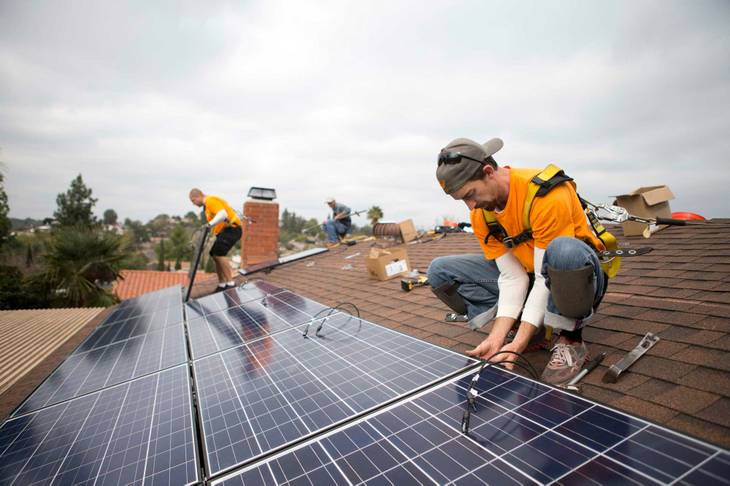Not long after Nevada utility regulators voted to increase bills for residents and small-business operators using solar energy, Robert Lamore started getting calls from customers of his business. The callers were frustrated and concerned.
And rightfully so, believes Lamore, the owner of a solar company that installs panels on roofs. Within days after the vote, he would help cancel about 75 pending contracts for panel installations. For those customers, who had already applied for solar with NV Energy, it no longer made financial sense to go through with the installation.
“I couldn’t even give a number of that,” Lamore said of how many calls he had received. “It was such a flurry, and it was so fast.”
When the state's three-member Public Utilities Commission OK'd the bill increase, industry advocates declared the new rate structure a poison pill for the market. The commission tripled a fixed fee over 12 years and slashed the value of credits customers earn by generating excess electricity through net metering.
The commission’s rationale for the new rate was that it would more accurately reflect the cost of having solar customers on the grid and prevent shifting that cost to other nonsolar ratepayers. The old rules, commissioners say, were created when solar was more expensive and when few solar customers were connected to the grid.
But the industry said the move put a pin through the ballooning solar industry, in which customers rely on low utility bills to offset their investment in solar panels.
Now, more than one month after the new rates went into effect, there remains a great deal of uncertainty about the future of the rooftop solar industry in Nevada. Whether attributable to customer confusion, the new rates or the departure of solar firms, recent data appears to make one trend evident: rooftop solar sales have dwindled to a trickle.
And that trickle has sent ripples through the industry, affecting local installers and leaving customers confused about what’s next.
Rooftop solar applications plummet
In December, 1,311 residents in Southern Nevada submitted applications with NV Energy to start the process of installing and connecting solar panels. According to NV Energy data, that number fell to 90 applications in January — a decrease of 93 percent.
Lyndon Rive, CEO of SolarCity, the national solar company chaired by Tesla Motors founder Elon Musk, said the decrease was a reaction to the new rate structure.
“It’s becoming increasingly clear that the (commission’s) rate hikes ended the rooftop solar industry in Nevada and took away citizens’ right to produce their own power at home,” Rive said in a statement. “Now that the state has seen the impact of the (commission) ruling, we hope they will reconsider this decision."
Part of the reason for the decrease in applications, others said, could be that at least six solar companies, including national giants SolarCity and Sunrun, have pulled their sales operations from the state when the new rates were implemented.
A significant contraction of the market is not unprecedented after a regulatory decision, said Davide Savenije, a senior editor at the trade publication Utility Dive. He notes that when Arizona utility Salt River Project added a $50 demand charge, SolarCity reported a 96 percent decrease in applications.
“You can see that those numbers are actually pretty similar,” he said.
He added that these metrics matter because many regulators, utilities and solar companies across the nation were watching the effects of the decision here.
“When a precedent is set in a decision like this, other people are paying attention,” he said. “I think you are going to see the ripple effects of this decision in other states and in other regions.”
Local installers see a changing market
Before the commission issued its decision in December, Scott Shaw, an executive with local installer Go Solar, said the company had fielded more than 25 orders. After the decision, that number went down to two.
The company, founded in 2010, performed one installation in December and one in January. The customers who placed those orders felt the value proposition still existed for them because they had smaller rooftop solar systems, meaning they had relatively low up-front costs and weren't affected by the decrease in net metering credits because they weren't expecting to generate excess power.
The company laid off more than a dozen employees and is shifting its focus to other energy efficient technologies.
Frank Rieger, CEO of Las Vegas-based Sol-Up USA, said before the regulatory process started several months ago, his company had been averaging about one order per day. In the last three months, he said it had sold two systems. Since the decision: zero sales.
But he reasons that “even the worst regulation” is better than uncertainty. “The clients have a business model that they can at least work with,” Rieger said.
However, Rieger said he expected the ruling to be challenged and overturned in court.
“Quite honestly, I think the current regulation is not going to stand up, anyway," he said.
While most companies believe the commission decision severely weakened the value proposition for going solar, some believe that there still might be some room for the industry. Savenije said that while companies have retreated because of the rates, “that doesn’t mean that solar is never going to be economical in Nevada.” Solar might remain advantageous for some state residents based on their individual circumstances, he said, and the ruling also might force solar companies to change their financing and offers.
Customers are in limbo
From the perspective of installation companies, Henderson should be a prime location for rooftop solar. It has a high density of homes, and sunlight hits it nearly 365 days out of the year.
But installations there fell sharply in January. According to building permits, the city approved 11 installations, compared to more than 200 in December. It was not immediately clear that data listed on the websites of other municipalities reflect final building permits, which indicate the approval of installations.
As of Feb. 11, NV Energy reported 19,310 net metering customers statewide. But the number of people affected by the decision is larger. NV Energy also had an additional 12,433 customers with pending applications.
Many customers have tried to ditch rooftop solar but are stuck for a variety of different reasons. Customers typically sign contracts to lease panels or purchase solar energy with companies like SolarCity and Sunrun before their panels are ever installed. After the commission decision, the companies allowed some of these customers to pull out of contracts if their panels had not been installed. Sunrun said close to 1,000 pre-install customers canceled contracts.
But once the panels were installed, consumers were locked into the contracts, which generally last 20 years. Some faced other long-term financial obligations, like bank loans for those who opted to purchase solar systems as opposed to leasing them.
Henderson resident Manny Sayegh, who has been using solar power for about six months, said the new rates altered the equation for paying off his system. Most solar customers get a lease because they believe lower utility bills will allow them to break even or profit on their payments to solar companies.
“We’re stuck either way,” he said of the contract.
Amid the turmoil over rates, Nevadans have filed lawsuits against NV Energy and SolarCity, and solar companies have vowed to restore the pre-ruling rate structure. A group backed by SolarCity is pushing a ballot measure that would effectively bring back the rates, and is urging legislators to call a special session. In the coming weeks, the Alliance for Solar Choice also plans to challenge the commission decision in court. Other affected parties are exploring similar action. Because the bill increases will be gradually implemented over 12 years, the next increase will not occur until 2019, giving the Legislature an opportunity to take up the matter during its next session.
“Most of the impact of the rate hikes will be felt after this year, which gives us time to fight on behalf of our customers,” Chandler Sherman, a spokesperson for SolarCity, said Tuesday in a statement. “The majority of Nevadans disagree with the PUC’s decision and we are confident that if the Legislature doesn’t do the right thing, the people will have a chance to overrule them.”

